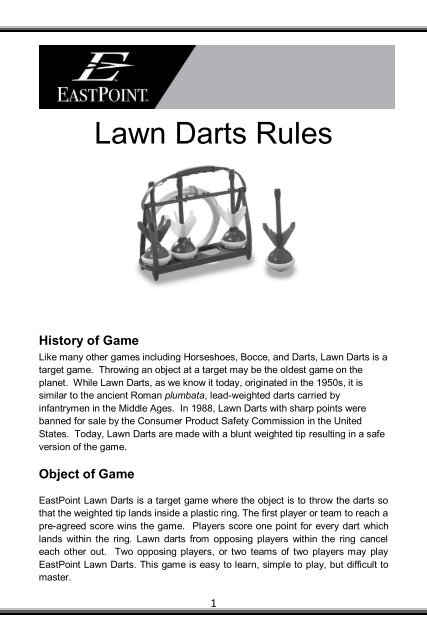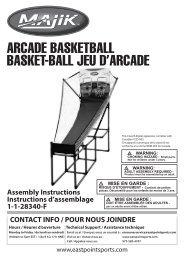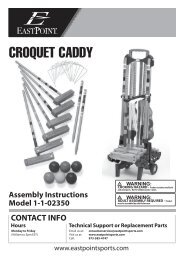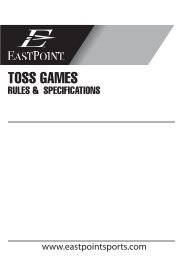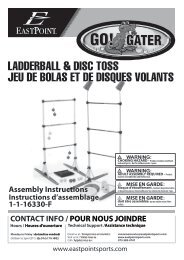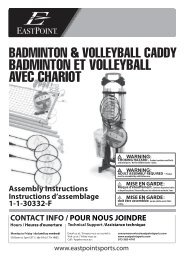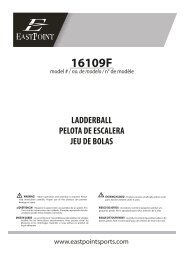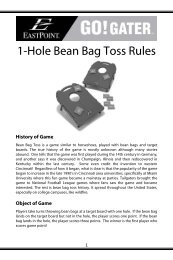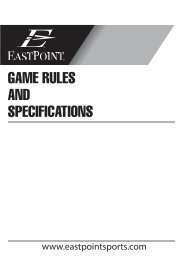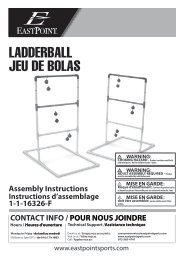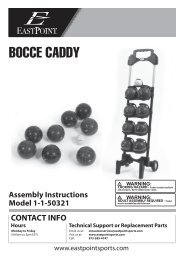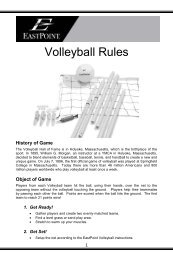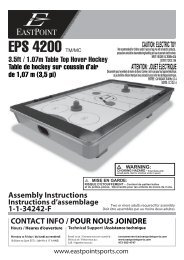Create successful ePaper yourself
Turn your PDF publications into a flip-book with our unique Google optimized e-Paper software.
<strong>Lawn</strong> <strong>Darts</strong> <strong>Rules</strong><br />
History of Game<br />
Like many other games including Horseshoes, Bocce, and <strong>Darts</strong>, <strong>Lawn</strong> <strong>Darts</strong> is a<br />
target game. Throwing an object at a target may be the oldest game on the<br />
planet. While <strong>Lawn</strong> <strong>Darts</strong>, as we know it today, originated in the 1950s, it is<br />
similar to the ancient Roman plumbata, lead-weighted darts carried by<br />
infantrymen in the Middle Ages. In 1988, <strong>Lawn</strong> <strong>Darts</strong> with sharp points were<br />
banned for sale by the Consumer Product Safety Commission in the United<br />
States. Today, <strong>Lawn</strong> <strong>Darts</strong> are made with a blunt weighted tip resulting in a safe<br />
version of the game.<br />
Object of Game<br />
<strong>EastPoint</strong> <strong>Lawn</strong> <strong>Darts</strong> is a target game where the object is to throw the darts so<br />
that the weighted tip lands inside a plastic ring. The first player or team to reach a<br />
pre-agreed score wins the game. Players score one point for every dart which<br />
lands within the ring. <strong>Lawn</strong> darts from opposing players within the ring cancel<br />
each other out. Two opposing players, or two teams of two players may play<br />
<strong>EastPoint</strong> <strong>Lawn</strong> <strong>Darts</strong>. This game is easy to learn, simple to play, but difficult to<br />
master.<br />
1
1. Get Ready!<br />
<br />
<br />
<br />
Gather one other player or three other players and create two teams.<br />
Select an open area without overhead objects, such as clotheslines or<br />
trees, and about 10 feet wide and 50 feet long.<br />
Stretch to warm up your muscles.<br />
2. Get Set!<br />
<br />
<br />
<br />
<br />
<br />
<br />
Place the two target rings about 35 feet apart. The distance between<br />
target rings may be decreased for younger players, or increased to<br />
about 60 feet for a more challenging game, if space permits.<br />
Watch out for people and pets in the playing area. The players and<br />
spectators not currently throwing a <strong>Lawn</strong> Dart are responsible for<br />
watching to make sure that the game area is safe. They are<br />
responsible for alerting both the throwing player of unsafe conditions,<br />
and any nearby people or pets to stop and stay away from the path of<br />
the <strong>Lawn</strong> Dart. It is the thrower’s responsibility to be watchful before<br />
swinging and releasing the <strong>Lawn</strong> Dart.<br />
Practice throwing the <strong>Lawn</strong> <strong>Darts</strong>. To throw one, hold it from the top,<br />
not the blunt tip, and toss underhand. See Figure A.<br />
<strong>EastPoint</strong> <strong>Lawn</strong> <strong>Darts</strong> must land with the weighted tip inside the target<br />
ring to count for a point. If the tip rests on top of the target ring for any<br />
reason, more than half the tip must be inside the ring to count as a<br />
point. See Figure B.<br />
Decide on game points before starting the game. Possible game<br />
points include 3, 15, or 21 points.<br />
Flip a coin to determine the player or team who throws first to begin<br />
the game.<br />
Figure A:<br />
Throwing the <strong>EastPoint</strong> <strong>Lawn</strong> Dart<br />
2
Figure B:<br />
Scoring for <strong>Lawn</strong> <strong>Darts</strong><br />
IN<br />
IN<br />
OUT<br />
3. Go Play!<br />
<br />
<br />
Keep score verbally.<br />
A point is scored when a <strong>Lawn</strong> Dart lands in the target ring. However,<br />
if a player lands a <strong>Lawn</strong> Dart in the target ring, and then an opposing<br />
player also lands a dart in the target ring, the scores cancel each<br />
other out. For example, if Team A landed two <strong>Lawn</strong> <strong>Darts</strong> in the<br />
target ring and Team B landed one <strong>Lawn</strong> Dart in the target ring, Team<br />
A would score one point and Team B would score no points.<br />
Game Variations<br />
Handly Cup Style <strong>Lawn</strong> <strong>Darts</strong><br />
In Handly Cup Style <strong>Lawn</strong> <strong>Darts</strong>, points are given for <strong>Lawn</strong> <strong>Darts</strong> landing in the<br />
target ring plus darts closer to the ring than any of the opposing team's darts.<br />
<strong>Darts</strong> that land inside the ring are worth 3 points each, and any <strong>Lawn</strong> Dart<br />
outside the ring that is closer to the ring than any other <strong>Lawn</strong> Dart by the<br />
opposing team is worth one point. For example, if neither team managed to place<br />
a dart inside the ring, but one team had two <strong>Lawn</strong> <strong>Darts</strong> closer than any of the<br />
opposing team’s <strong>Lawn</strong> <strong>Darts</strong>, the team would score 2 points. A <strong>Lawn</strong> Dart<br />
thrown inside the ring can be cancelled by an opposing team also throwing a dart<br />
into the ring. If both teams have darts in the ring, then no darts outside the ring<br />
may score.<br />
3
Handly Cup Style matches usually are played with two teams which alternate<br />
throws and keep track of points, until one team scores a total is 21 or more.<br />
Game Trivia<br />
<br />
The F-16 Fighter Falcon aircraft was nicknamed the “<strong>Lawn</strong> Dart” due<br />
to its resemblance and nine crashes that occurred in 2007.<br />
4
Règlements de fléchettes<br />
de pelouse<br />
L’histoire du jeu<br />
Similaires aux autres jeux y compris le fers à cheval, le jeu de boules et le jeu de<br />
fléchettes, le jeu de fléchettes de pelouse se joue avec une cible. Lancer un objet<br />
à une cible peut être le jeu le plus vieux sur la planète. Le jeu de fléchettes de<br />
pelouse que nous connaissons aujourd'hui a sa naissance dans les années<br />
1950. Il est semblable au jeu Romain antique plumbata, où des fléchettes<br />
pondérées par le plomb, ont été portées par des fantassins au Moyen Age. En<br />
1988, les fléchettes de pelouse avec des points pointus ont été interdites pour la<br />
vente par la Consumer Product Safety Commision (commission pour la défense<br />
du consommateur) aux Etats-Unis. Aujourd'hui, les fléchettes de pelouse sont<br />
produites avec un bout pondéré souple pour avoir une version du jeu de sécurité.<br />
Le but du jeu<br />
Le jeu de fléchettes de pelouse <strong>EastPoint</strong> est un jeu de cible avec le but de lancer<br />
les fléchettes pour que le bout pondéré atterrisse à l'intérieur d'un anneau en<br />
plastique. Le premier joueur ou équipe à atteindre un pointage prédéterminé serait<br />
le victoire. Les joueurs marquent un point pour chaque fléchette qui repose dans<br />
l'anneau. Les fléchettes de pelouse des joueurs (ou des équipes) qui marquent,<br />
s’annulent. Le jeu de fléchettes de pelouse <strong>EastPoint</strong> peut être joué par deux<br />
joueurs, ou deux équipes. C’est facile d'apprendre, facile à jouer, mais difficile de<br />
maîtriser.<br />
5
1. Préparez-vous.<br />
<br />
<br />
<br />
2. Prêt.<br />
<br />
<br />
<br />
<br />
<br />
<br />
Réunissez un autre joueur ou trois autres joueurs et créez deux<br />
équipes.<br />
Trouvez un endroit ouvert sans obstacles aériens, comme des cordes<br />
à linge ou des arbres, et avec environ 3 m (10 pi) de largeur et<br />
15,2 m (50 pi) de longueur.<br />
Etirez-vous pour réchauffer vos muscles.<br />
Placez les deux anneaux cibles à environ 10,7 m (35 pi) à part. La<br />
distance entre des anneaux cibles peut être diminuée pour des<br />
joueurs plus jeunes, ou augmentée à environ 18,3 m (60 pi) pour un<br />
jeu plus stimulant, si l'espace permet.<br />
Faites attention aux gens et aux animaux de compagnie dans<br />
l’endroit de jouer. Les joueurs inactifs et les spectateurs sont<br />
responsable de faire attention au secteur de jour pour s'assurer la<br />
sécurité. Ils sont responsables d'alerter aux joueurs actifs et aux<br />
spectateurs des conditions risquées et de garder loin du jeu des<br />
autres personnes et des animaux de compagnie. C'est la<br />
responsabilité du lanceur d'être vigilant avant de balancer ou lancer la<br />
fléchette de pelouse.<br />
Pratiquez lancer une fléchette de pelouse. Pour en lancer, tenez-la par le<br />
haut, et non pas par le bout souple. Lancez-la par en-dessous. Voir la<br />
figure A.<br />
Les fléchettes de pelouse <strong>EastPoint</strong> doivent atterrir avec le bout<br />
pondéré à l'intérieur de l'anneau cible pour marquer un point. Si la<br />
fléchette touche l’anneau cible, pour n'importe quelle raison, plus que<br />
la moitié du bout doit être à l'intérieur de l'anneau pour marquer un<br />
point. Voir la figure B.<br />
Choisissez le montant total nécessaire pour gagner la partie avant de<br />
la commencer. Des possibilités de pointage comprend 3, 15, ou 21<br />
points.<br />
Lancez une pièce de monnaie pour déterminer qui commencera la<br />
partie.<br />
6
Figure A:<br />
Lancement de la fléchette de pelouse<br />
Figure B:<br />
Pointage de la fléchette de pelouse<br />
DEDAN<br />
S<br />
DEDAN<br />
S<br />
DEHOR<br />
S<br />
3. Jouez.<br />
<br />
<br />
Répétez le pointage verbalement.<br />
Un point est marqué quand une fléchette de pelouse atterrit dans<br />
l'anneau cible. Cependant, si un joueur atterrit une fléchette de<br />
pelouse dans l'anneau cible et ensuite l’adversaire pose aussi une<br />
fléchette de pelouse dans l'anneau cible, les points s’annulent. Par<br />
exemple, si l'équipe A pose une fléchette de pelouse dans l'anneau<br />
cible et l'équipe B atterrit une fléchette de pelouse aussi dans<br />
l'anneau cible, l'équipe A marquerait un point et l'équipe B marquerait<br />
un point, donc les points s’annulent.<br />
7
Variations de jeu<br />
Jeu de fléchettes de pelouse de style Coupe Handly<br />
Dans le jeu de fléchettes de pelouse de style Coupe Handly, des points sont<br />
marqués pour les fléchettes de pelouse qui atterrissent dans l'anneau cible et<br />
pour tous les fléchettes plus proche à l'anneau que d’autre fléchette adversaire.<br />
Les fléchettes qui atterrissent à l'intérieur de l'anneau valent 3 points et toute<br />
fléchette de pelouse à l'extérieur de l'anneau qui est plus proche à l'anneau que<br />
d’autre fléchette adversaire vaut un point. Par exemple, si aucune équipe n'a<br />
réussi à placer une fléchette à l'intérieur de l'anneau, mais une équipe avait deux<br />
fléchettes plus proches à l’anneau que les fléchettes de pelouse adversaire,<br />
cette équipe marquerait 2 points. Une fléchette de pelouse lancée à l'intérieur de<br />
l'anneau peut être annulée par une fléchette de l’équipe adversaire aussi dans<br />
l'anneau. Si les deux équipes ont une fléchette dans l'anneau, donc aucune<br />
fléchette à l'extérieur ne peut marquer des points.<br />
Les matchs de style Coupe Handly sont d'habitude jouées avec deux équipes qui<br />
alternent des lancements et guardent le pointage, jusqu'à ce qu’une équipe<br />
arrive à un montant de 21 points ou plus.<br />
Fait anecdotique<br />
L'avion Fighter Falcon F-16 a été surnommé la « la fléchette de pelouse » à<br />
cause de sa ressemblance et des neuf accidents qui sont arrivés en 2007.<br />
8<br />
RB022F_185.187


